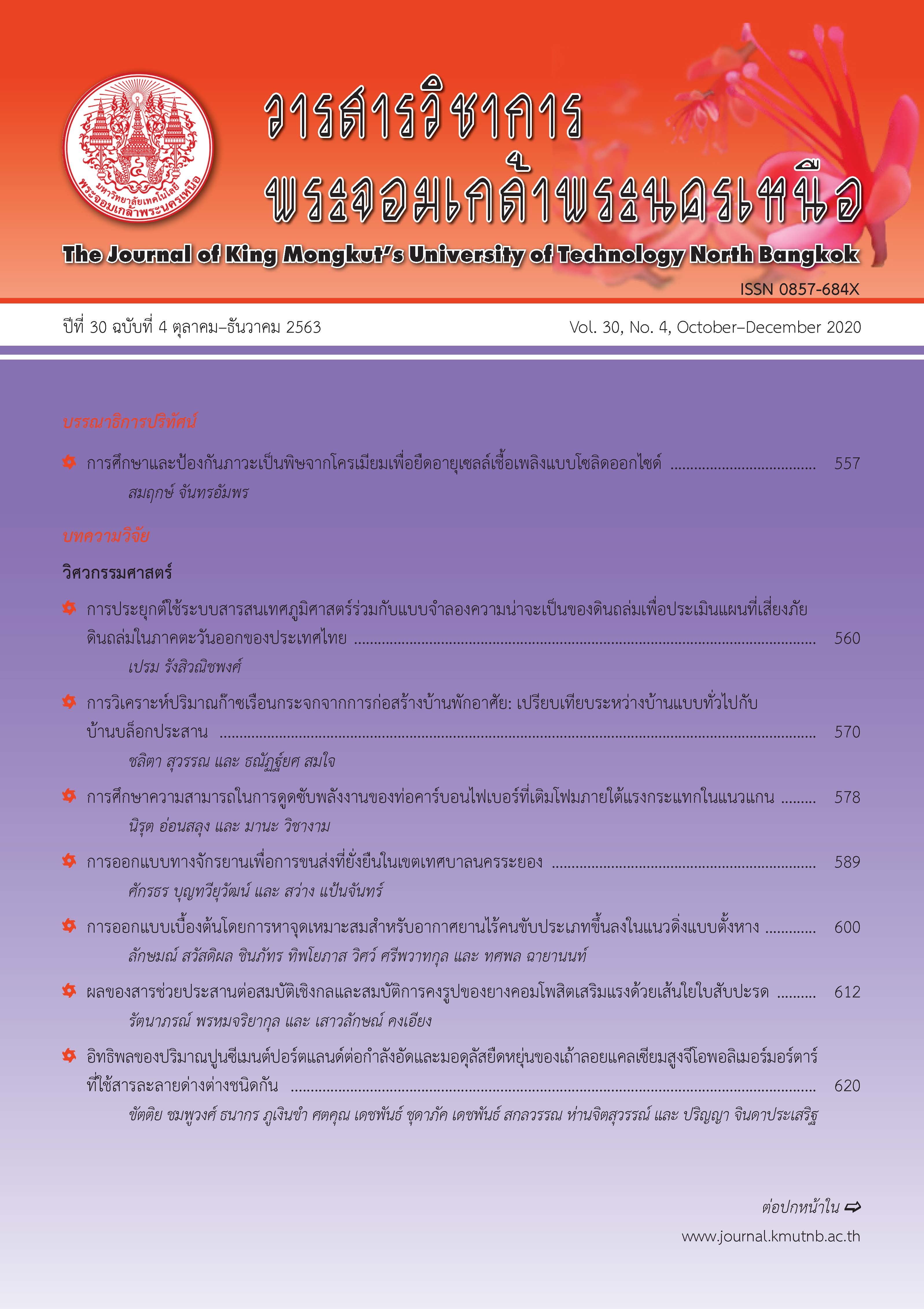ตัวแบบการเพิ่มประสิทธิภาพขั้นตอนวิธีการจัดกลุ่มเพื่อการวิเคราะห์ลักษณะประจำที่จำเป็นของรูปแบบแพ็กเกจการท่องเที่ยวสำหรับตลาดการท่องเที่ยวแบบอินบาวด์ในประเทศไทย
Main Article Content
บทคัดย่อ
งานวิจัยนี้เสนอตัวแบบการเพิ่มประสิทธิภาพขั้นตอนวิธีการจัดกลุ่มเพื่อการวิเคราะห์หาลักษณะประจำที่จำเป็นของรูปแบบแพ็กเกจการท่องเที่ยวสำหรับตลาดการท่องเที่ยวแบบอินบาวด์ โดยใช้สองกระบวนการคือ ขั้นตอนวิธีการจัดกลุ่ม ได้แก่ ขั้นตอนวิธีเคมีน ขั้นตอนวิธีการจัดกลุ่มตามลำดับชั้น ขั้นตอนวิธีการจัดกลุ่มแบบสุ่ม และขั้นตอนวิธีดีบีสแกน และร่วมกับการวิเคราะห์หาลักษณะประจำ ได้แก่ ขั้นตอนวิธีการหาค่าที่เหมาะสมที่สุดแบบวิวัฒนาการ และขั้นตอนวิธีการหาค่าเหมาะสมที่สุดแบบกลุ่มอนุภาค ผู้วิจัยใช้ข้อมูลแพ็กเกจท่องเที่ยวของผู้ประกอบธุรกิจการท่องเที่ยวแบบอินบาวด์จากเว็บไซต์ของกรมการท่องเที่ยวแห่งประเทศไทย ประจำปี พ.ศ. 2561 จำนวน 717 ระเบียน แต่ละระเบียนมีลักษณะประจำของข้อมูลประกอบด้วย 26 ลักษณะประจำของข้อมูล ผลการวิจัยพบว่า กระบวนการเพิ่มประสิทธิภาพของขั้นตอนวิธีการจัดกลุ่ม คือ ขั้นตอนวิธีการหาค่าเหมาะสมที่สุดแบบกลุ่มอนุภาคดีที่สุด และตัวแบบการจัดกลุ่มที่ดีที่สุดคือ ดีบีสแกน ด้วยค่าดัชนีเดวีส์-โบลดิน 0.813 ลดลงเหลือ 0.369 คิดเป็นประสิทธิภาพที่เพิ่มขึ้น 54.612% จำนวนกลุ่ม 10 กลุ่ม และผลการวิเคราะห์ลักษณะประจำที่จำเป็นของรูปแบบแพ็กเกจการท่องเที่ยวประกอบไปด้วย 5 ลักษณะประจำ ได้แก่ สถานที่ท่องเที่ยวหลักที่ 1 กิจกรรมการท่องเที่ยวทะเลและชายหาด กิจกรรมการกีฬา/เล่นกอล์ฟ กิจกรรมอบรมทำอาหารไทย และกิจกรรมอื่นๆ เช่น การนั่งเรือหางยาว การนั่งรถตุ๊กตุ๊ก และการทำธุรกิจ ข้อค้นพบจากการวิจัยช่วยให้ผู้ประกอบการการท่องเที่ยวสามารถนำไปใช้พัฒนาตัวแบบการจัดกลุ่มของรูปแบบแพ็กเกจการท่องเที่ยวให้สอดคล้องกับความต้องการของตลาดการท่องเที่ยวแบบอินบาวด์ในอนาคตได้
Article Details
บทความที่ลงตีพิมพ์เป็นข้อคิดเห็นของผู้เขียนเท่านั้น
ผู้เขียนจะต้องเป็นผู้รับผิดชอบต่อผลทางกฎหมายใดๆ ที่อาจเกิดขึ้นจากบทความนั้น
เอกสารอ้างอิง
[2] Ministry of Tourism and Sport. (2015, Jul.). Development tourism strategic plan (2016–2020). Ministry of Tourism and Sport Bangkok, Thailand, [Online]. Available: https://www.mots.go.th/ewt_dl_link.php?nid=7114
[3] D. R. Fesenmaier and Z. Xiang, “Introduction to tourism design and design science in tourism,” Design science in tourism, pp. 3–16, 2017.
[4] Office of the nation economic and social development council, “Development nation economic and social no. 12 (2016–2020),” Office of the nation economic and social development council. Bangkok, Thailand, 2019
(in Thai).
[5] W. Yotsawat, S. Purisangkaha, W. Kittirakpunya, and A. Srivihok, “Development of domestic tourists model using clustering and association rule technique case study: Phra Nakhon Si Ayuttaya province,” The Journal of KMUTNB, vol. 27, no. 4, pp. 829–841, 2017 (in Thai).
[6] Q. Liu, Y. Ge, Z. Li, E. Chen, and H. Xiong, “Personalized travel package recommendation,” presented at the 11th IEEE International Conference on Data Mining, ICDM 2011, Vancouver, BC, Canada, December 11–14, 2011.
[7] T. Angsakul and J. Angsakul, “A personalized system for travel attraction recommendation using a clustering technique and analytic hierarchy process,” Suranaree Journal of Social Science, vol. 8, no. 2, pp. 87–109, 2014 (in Thai).
[8] T. Theeramunkong, Introduction to Concepts and Techniques in Data Mining and Application to Text Mining Second Edition. Bangkok: Thammasat University Press, Thammasat Printing House, 2017 (in Thai).
[9] E. M. Jane and E. G. D. P. Raj, “Comparative study on partition based clustering algorithms,” International Journal of Research in Advent Technology, vol. 6, no. 9, pp. 2321–9637, 2018.
[10] J. Han, Data Mining: Concepts and Techniques, Second Edition. University of Illinois at Urbana-Champaign Micheline Kamber, 2006.
[11] A. J. Gates and Y. Y. Ahn, “The impact of random models on clustering similarity,” The Journal of Machine Learning Research, vol. 18, no. 1, pp. 3049–3076, 2017.
[12] RapidMiner. (2019, Jan). Rapid Miner 6.0 User Manual. [Online], Available: https://docs.rapidminer.com/download/RapidMiner-v6-user-manual.pdf.
[13] M. Sibuya, “A random clustering process,” Annals of the Institute of Statistical Mathematics, vol. 45, no. 3, pp. 459–465, 1993.
[14] I. H. Witten and E. Frank, Data Mining: Practical Machine Learning Tools and Techniques, 2nd ed. Morgan Kaufmann, San Francisco, 2005.
[15] X. Yu and M. Gen, Introduction to Evolutionary Algorithms. Springer Science & Business Media, 2010.
[16] R. L. Haupt and D. H. Werner, Genetic Algorithms in Electromagnetics. John Wiley & Sons, 2007.
[17] A. Viji, A. Mary, and T. Jibarajan, “Performance metrics of clustering algorithm,” Indian Journal of Applied Research, vol. 4, no. 8, pp. 165–167, 2014.
[18] K. Jaroenrat, “Particle swarm optimization for open shortest path first network’s traffic engineering,” Information Technology Journal, vol. 11, no. 1, pp. 43–52, 2015 (in Thai).
[19] T. N. Tran, K. Drab, and M. Daszykowski, “Revised DBSCAN algorithm to cluster data with dense adjacent clusters,” Chemometrics and Intelligent Laboratory Systems, vol. 120, pp. 92–96, 2013.
[20] The Department of Tourism. (2018, November). Tourism Authority of Thailand. Ministry of Tourism and Sports. Bangkok, Thailand [Online]. Available: https://www.tourismthailand.org

